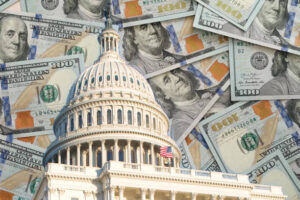Fed Rate Cuts in 2025: Balancing Inflation & Recession Risks

Percentage model and up and down arrow. The concept of changing interest rates in banks falling and rising abstractly on a wooden block. Close-up. Arrows rise and fall on wooden blocks
Background of Fed Rate Cuts in 2025: Balancing Inflation & Recession Risks
Fed Rate Cuts in 2025: Monetary Policy Decisions Are Pivotal in Shaping the U.S. Economy. In 2025, the Fed faces a complex economic landscape characterised by persistent inflation and the looming threat of a recession. Balancing these factors, the Fed has initiated interest rate cuts, aiming to stimulate economic activity while remaining vigilant about inflationary pressures.

The Fed’s Rate Cut Decisions
1. September 2025 Rate Cut
In September 2025, the Federal Reserve reduced the federal funds rate by 0.25 percentage points to a range of 4.00%–4.25%. This decision marked the first rate cut of the year, reflecting concerns over a weakening labor market and the need to support economic growth.
2. Projected Rate Cuts for 2025 and 2026
The Fed’s updated projections indicate two additional rate cuts in 2025, bringing the federal funds rate to approximately 3.50% by the end of the year. Looking ahead, one more rate cut is anticipated in 2026, potentially lowering the rate to 3.25%–3.50%.
Inflation Concerns
Despite the Fed’s efforts to combat inflation, core inflation remains above the 2% target. As of August 2025, core Personal Consumption Expenditures (PCE) inflation stood at 2.9%. Fed officials, including Vice Chair Philip Jefferson, have emphasized the importance of aligning monetary policy with the dual mandate of maximum employment and stable prices.
Additionally, rising commodity prices and potential tariff-induced cost increases pose risks to inflation stability. Federal Reserve Bank of Chicago President Austan Goolsbee has expressed concerns about the possibility of stagflation if inflation continues to rise amid economic slowdown.
Market Expectations
Financial markets have reacted to the Fed’s rate cut decisions with varying expectations. The CME Group’s FedWatch tool indicates a 98% probability of a 0.25% rate cut in October 2025, with another 90% probability for a subsequent cut in December.
However, some analysts caution against aggressive rate cuts, suggesting that over-easing could exacerbate inflationary pressures. Bank of America, for instance, has moved its rate cut forecast from December to October, citing signs of a weakening labor market.
Impact on Borrowing Costs and Housing Market
The Fed’s rate cuts have implications for borrowing costs and the housing market. Lower interest rates can reduce mortgage rates, potentially making homeownership more affordable. However, if inflation remains elevated, the benefits of lower rates may be offset by higher costs of living.

Stock Market Reactions
The stock market has shown mixed reactions to the Fed’s rate cut decisions. While rate cuts can stimulate economic activity and boost corporate earnings, concerns about persistent inflation and potential stagflation weigh on investor sentiment.
Credit Markets and Financial Institutions
Financial institutions are closely monitoring the Fed’s rate cuts, as changes in interest rates affect lending practices and credit availability. Lower rates can encourage borrowing and investment but may also compress profit margins for banks.

Outlook for 2026
Looking ahead to 2026, the Fed’s monetary policy will continue to be influenced by the interplay between inflation and economic growth. While some analysts anticipate further rate cuts, others warn that premature easing could undermine efforts to control inflation. The Fed’s ability to navigate these challenges will be crucial in shaping the economic landscape in the coming years.
Conclusion
The Federal Reserve’s interest rate decisions in 2025 reflect a delicate balancing act between fostering economic growth and controlling inflation. As the economy evolves, the Fed’s policies will play a pivotal role in determining the trajectory of borrowing costs, housing markets, and overall economic stability.







